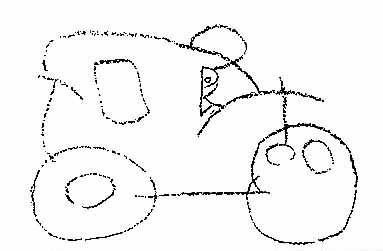commentary
Drawing Is Basic
A response to What Elementary
Generalist Teachers Need To Know to Teach Art Well (November, 1999)
by Jean Morman Unsworth
|
This
essay is republished here with permission from the author and the National
Art Education Association. This article first appeared in
Art
Education:
The Journal of the National Art Education Association.
Volume 54, No. 6, November, 2001, pages 6 to 11.
The
Art Department at Goshen College is pleased to make this commentary accessible
to teachers, parents, and others who care deeply about the healthy development
of children.
TO
CONTACT
US
|
T
he
role of the classroom generalist teacher in the teaching of art runs the
gamut of no role at all to the total responsibility in schools which lack
art specialists. Paul Duncum took on the problem in his November,
1999 article in Art Education. This response questions several points
made in the article.
1. Legitimizing
copying and placing children so that copying is inevitable
(Duncum
,
p. 35)
This implies that there is a norm to which all children's
drawing must conform. It also places in the teacher's power the determination
of the haves and the have nots among a class of students. Stigmatizing
individual children in this way results in lifelong convictions that they
cannot draw.
Art is not a product arrived at through following
directions, copying, or conforming to a given model. Art is not just
skill. It is the
process
of thinking, imagining,
risking, seeing connections, inventing, expressing in unique visual form.
Drawing is as basic and essential a mode of
expression as is language and writing. Everyone can draw. And,
just as we all learn the same form of cursive writing but develop an individuality
that becomes our identification, so our drawing
|
|
develops as individually as our writing. The task
of a teacher is not to tell the student what it should look like; rather,
the teacher's role is to lead the student to look. There
is no absolute standard of good drawing.
Each artist has his/her
individual style. So too, every child will see and record individually.
To
put a standard before a class and require students to aim to copy it is
very destructive.
Drawing is first seeing, perception.
Duncum states: Very young children are unlikely to take notice of the subject
while drawing and they have difficulty with proportions. (Duncum, p. 35)
Creating a climate of quiet concentration, giving the children confidence
that they can draw, and leading them to let their eyes do the drawing
results in sensitive, perceptive drawings. Moreover, this kind of
perceptual training is a direct preparation for reading.
|
|
Illustration
1. "Truck" Christian Aquino,
Pre-K,
St. Matthias School, Chicago, IL
|
.
This Pre-K student drew a toy truck that was placed on his table.
He was asked to look at it and let his eyes crawl along every edge.
|
.
.
This drawing of a tree was done outside on the school grounds by a
second grade student. She drew not only the tree, but details of
background objects as well.
"Tree."
by Richard Guzman, Grade 2, St. Gertrude School, Chicago, IL
Perception can also be nurtured by stimulating the memory. These
two drawings of her home by a fourth grade student were done, first from
memory at school (left) and then looking at the house (right). Both
drawings are remarkable for their detail. The memory drawing has
a charm that is somewhat lost in the search for details of the second drawing.
|
|
"My
Home" from memory (left) and then from observation by Ginny Robinson, Grade
4,
Gates
Elementary School, Chesterfield, VA.
2. If
teachers make images for children, they should, following the principle
of plus one phenomena, attempt to make images in only a slightly
more sophisticated way than the children.
(Duncum,
p. 35)
|
Teachers should never draw for the students. No matter
how good or bad the teacher's drawing is, the students will think
that they must copy, resulting in feelings of inadequacy and failure.
To intentionally draw to their level is an insult to the children.
No two draw alike, so how can such a standard be determined?
|
|
Comparing the process of art to norms of acquisition of knowledge in
a factual learning environment, Viktor Lowenfeld points out that in factual
learning the students responses are judged as growth, although they may
be primarily mimicking the teacher's own values. (Lowenfeld and Brittain,
1987, p. 34) It is possible for art to fall into the same trap.
And the Wilson scenario sets the stage.
|
3.
Contrary to perceptual strategy, this strategy (the Wilsons) is based
upon children learning to make pictures from studying other pictures, not
from life.
(Duncum)
This approach sees drawing as a technique to be mastered,
not as a natural means of expression. And the technique would seem
to be found in the tricks of the trade employed by adult artists.
Certainly, children
should see, enjoy, and study the work of artists through the ages.
Looking at drawings by Rembrandt and Matisse, for example, and comparing
their styles, is a stimulating and broadening experience. It is also
important, however, when looking at the drawings of great artists, to see
that often they are thinking with their pencil.
|
|
Seeing the many wrong lines in a Matisse or a Delacroix drawing,
lines they drew and then rethought and drew again, is an important
way to encourage students to risk drawing and not to be inhibited by fear
of messing up.
Further, drawing from actual objects
or posed models is the way that the adult artists themselves draw.
Why should children not enjoy this direct perception of nature and life?
Drawing is a direct path to awareness and perception of the marvels of
the world around us. For example, placing a group of middle grade
students around a model so they see all views and then comparing their
drawings is a stimulating learning experience.
|
|
These drawings of a model were done by fifth grade students. Whetting
the child's interest in discovering form all around him/her and wanting
to record its beauty is one of the best gifts teachers can give to their
students. If drawing must be done as a copy of anther's observation,
there is no motivation to really look at the world around one.
|
|
|
|
|
|
|
|
|
|
|
|
.
Drawings
from a model by fifth graders Adele Tobin, Meggie Cramer, Elly Knepper,
and Kevin McCarthy, St. Athanasius School, Evanston, Illinois
|
|
Goals in art education have varied with the time, corresponding to
social values. The Industrial Revolution created a need for skilled
factory workers, so art teaching introduced in England in 1850 was unimaginative,
aimed at skill of hand and eye. Arthur Wesley Dow and Friedrich Froebel
called attention to children's creative powers, resulting in a change of
direction in the 20th century. Entering the 21st century, we seem
to be reverting to the skill goals once again.
|
|
In a small book by R.R. Tomlinson, Senior Inspector of Art to the London
County Council and published in 1947, Franz Cizek, called by some the Father
of Art Education, is quoted making a clear case for creativity.
Cizek, while studying at the Academy of Fine Arts in Vienna, lodged with
a family of a carpenter. He observed the children of the family drawing
on a wood fence and noticed that their drawings differed sharply from the
drawings produced in school under formal direction.
|
Cizeks creed, quoted by Tomlinson, is this:
No
child should be subjected to a rigid course of technical education.
Ideas and methods of expression of adults should never be imposed
upon children. Children should be given a choice of material
with which to express and create. Their expression in the chosen
material should be allowed to mature according to their innate laws of
development. It should not be hastened artificially or altered to
satisfy adult ideas. Above all, children's efforts should never
be ridiculed and criticism should always be sympathetically given.
Care should be taken not to praise skill at the expense of creative ideas.
(Tomlinson,
1947, p. 20.)
|
Viktor Lowenfeld, who observed Cizek for several years,
also saw creative thinking as an essential part of the curriculum, giving
solid direction to this theory. He believed that every child is born creative
(Lowenfeld and Brittain, 1987, p.76).
|
|
So much of measured education results focus on convergent thinking,
where one correct answer is expected. Creativity is centered in divergent
thinking, the openness to the new. It establishes a climate for risk
and readiness to learn from failure instead of seeing it as a defeat.
|
Again, Lowenfeld:
I
f
we really expect to develop an inquiring mind in a child, one that is eager
to tackle the problems of today, a mind that is flexible, inquisitive,
and seeks for solutions in unusual ways, then the attention we have paid
to the so-called basic learning areas may be ill-placed. The arts
can play a tremendous role in learning and may be more basic to the thinking
process than the more traditional school subjects. Every drawing,
whether by a scribbling child or a high school student at the peak of learning
efficiency, demands a great deal of intellectual involvement.
(Lowenfeld
and Brittain, 1987, p. 53)
|
Every child up to second grade claims to be able to draw. It is a joy
to ask a class of first graders how many can draw. Every hand goes
up with enthusiasm. But by age eight or nine, many look critically
at their drawing and decide it is not up to their achievement level in
other subjects, or up to the adult criteria imposed on them, and they stop.
|
|
Unfortunately, many teachers accept their decision that
they do not draw and they are never again challenged. Encouraging
students to risk, to see drawing as a vehicle of discovery rather than
a skill to be mastered, is a way of bridging that crucial period and freeing
students to continue drawing.
|
In his
My Pedagogic Creed
, John Dewey brought together
these convictions:
-
I believe
in the so-called expressive or constructive activities as the center of
correlation.
-
I believe
that the active side precedes the passive in the development of the child-nature;
that expression comes before conscious impression.
-
I believe
that the image is the great instrument of instruction
And finally, from Duncum:
4.
Evaluation involves establishing a number of criteria against which to
judge a work, including imitation, expressiveness; aesthetics; and instrumentalism.
Initial description and analysis are designed to help facilitate justifiable
interpretations and reasoned judgments.
(Duncum, p.
37.)
|
I have read this and its context many
times and find it meaningless. Evaluation is important, but it should
be done with the children and in a way that encourages and reinforces their
efforts. Howard Gardners theory of Multiple Intelligences has extended
our understanding of the facets of the mind through which we learn.
Linguistic intelligence and logical-mathematical intelligence are only
two. Spatial intelligence, to power to perceive form and give visual
shape to ideas, is of equal importance. There are students who respond
much more readily to visual learning than to linear logic. The right brain
dominant child will often resist a linear approach. Also, children whose
family experience has not encouraged reading and factual mastery will often
be unprepared for the regimen of school, but will draw happily and readily.
|
|
In an interdisciplinary learning climate, every
subject should be approached both literally and expressively. A once
a week art lesson by the art specialist cannot begin to reach these dimensions.
Empowering classroom teachers to bring visual learning into their general
curriculum will not threaten the role of the art specialist. On the
contrary, art teachers who become resource persons for the classroom teachers
are valued far more than the specialist who functions merely as their "coffee
break."
Through the arts, students discover how to express
their individual capacity for imagination. Allowing learning
to be expressed imaginatively makes every concept personal and aesthetic.
In the arts as in life, the form of a thing is part of its content.
Giving visual shape to a concept in social studies, math, science adds
a meaning that facts and definitions cannot approach. These fourth grade
students studied and drew gargoyles from Notre Dame Cathedral in Paris.
|
|
|
-
left -
"Gargoyle
from Notre Dame Cathedral" by Sarah Leahy, Grade 4, Woolridge Elementary
School, Chesterfield, VA
-
right -
"Gargoyle
from Notre Dame Cathedral" by Allison Huebner, Grade 4, Woolridge Elementary
School, Chesterfield, VA
|
|
Drawing is an essential mode of expression, hence
of learning. Drawing, moreover, is a complementary mode of
learning, equal to writing and verbal expression and within the powers
of every person. Many cultures called "primitive" have no word
in their vocabulary for ART, because making ? and making things aesthetically
pleasing ? is such an integral part of their being. We have
far to go to achieve this wholeness of understanding of our world and our
power to express it.
It is linear thinking that stifles individuals'
drawing. Once empowered to RISK drawing with their eyes,
in other words, really following edges with their eyes and letting the
hand record them, everyone can draw. Experience has proved repeatedly that
classroom teachers who have never tried to draw can do a remarkable drawing
of their shoe at first attempt once they let go and let their eyes
do the drawing.
|
|
This kind of perceptual drawing has a
direct carryover to reading since it trains and disciplines the eyes to
follow a line and see details. Drawing, therefore, should be a mode
of expressing learning in every subject, combining with linear, "right
answer" thinking that too often tends to dominate the school learning climate.
There are too many sad examples of very bright children
who will not draw, who simply refuse to try. They have been so conditioned
to succeeding in factual exams that they find risking an "unsuccessful"
drawing to be traumatic. The arts are unique in their potential to
develop this necessary attitude toward risk taking and learning from "failure"
? the failure that comes from trying creative ideas and most often stimulates
new and better ideas.
|
The
greatest danger for most of us is not that we aim too high and we miss
it, but that we aim too low and we reach it.
. . . Michelangelo
REFERENCES
-
Dewey, John.
My Pedagogic Creed.
(1897). First published
in
School Journal
, January 16, 1897, LIV.
-
Duncum, Paul. (November, 1999). "What Elementary Generalist
Teachers Need To Know To Teach Art Well"
Art Education
," Art
Education, 52 (6) pp 33 - 37.
-
Lowenfeld, V. and Brittain, W. L. (1987).
Creative and Mental
Growth
, 4th edition. New York: Macmillan Publishing Company.
-
Tomlinson, R. R. (1947).
Children As Artists
. London and New
York: King Penguin Books
this page posted in November - 2001
CONTACTS
Jean Morman Unsworth
e-mail: unsworth@megsinet.net author
Marvin Bartel
e-mail: marvinpb@goshen.edu web page editor
Jean Morman Unsworth
is the author of :
-
Connecting: Integrating Art in the Curriculum
, Reading &
OReilly, Inc. Wilton, CT (1987).
-
Connections
- three games published by Dale Seymour Publications
(1992 - 95), and
-
The new series,
Drawing Is Basic,
classroom teacher manuals
Pre-K through Grade 6, on drawing and writing, Dale Seymour Publications,
2001.
-
She has written teacher resource supplements for the Glencoe/McGraw-Hill
junior high art series,
Exploring Art and Understanding Art
and co-authored the grade six text,
Introducing Art.
See
this
link
for Marvin Bartel's commentary on this commentary.
.
|










